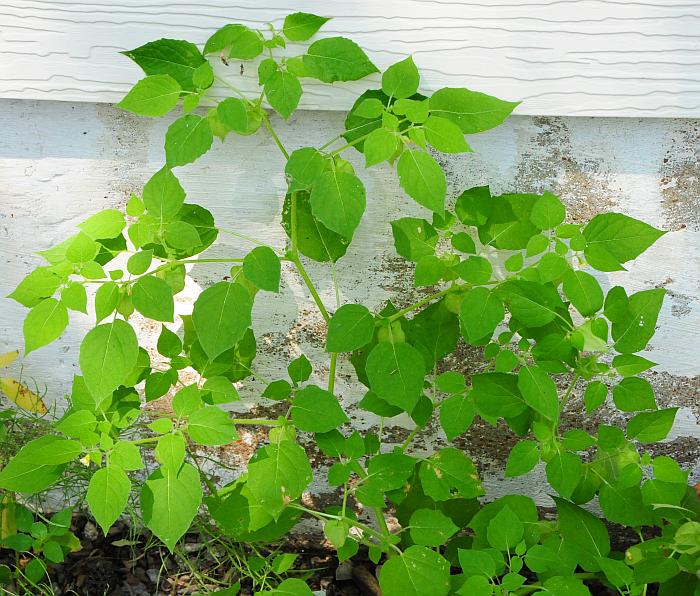Physalis missouriensis Mack. & Bush
Missouri Ground Cherry

Native
CC = 5
CW = 5
MOC = 31
© SRTurner
Physalis missouriensis Mack. & BushMissouri Ground Cherry | |
 |
Native CC = 5 CW = 5 MOC = 31 |
© SRTurner |
|
Family - Solanaceae Habit - Taprooted annual forb. Stem - Ascending, to 55 cm, with several to many, loosely ascending to spreading branches, moderately to densely pubescent with short, spreading, multicellular, gland-tipped and sometimes also nonglandular hairs 0.1-0.5 mm long.
Leaves - Alternate, simple, mostly long-petiolate, thin-textured. Blades 2-10 cm long, broadly ovate or nearly circular, angled or short-tapered to a usually bluntly pointed tip, broadly rounded to more or less truncate or occasionally shallowly cordate at the base, the margins relatively sparsely toothed (with 1-5 teeth along each side), glandular-hairy, the teeth bluntly pointed, shallow and broad, the surfaces green to dark green when fresh, sparsely to moderately pubescent (more densely on the undersurface) along the veins with short, gland-tipped, multicellular hairs.
Inflorescences - Solitary flowers in leaf axils. Flower stalks 4-7 mm long, becoming slightly elongated to 5-10 mm at fruiting.
Flowers - Calyces 2.5-4.0 mm long at flowering, the lobes 1-2 mm long, the outer surface with dense, short, multicellular, gland-tipped hairs at flowering, Corollas 5-7 mm long, uniformly pale yellow to lemon yellow, the inner surface occasionally with pale purplish markings toward the base. Stamens 5, with slender filaments half as wide as the anthers or narrower, the anthers 1.0-1.5 mm long, yellow, arched but not coiled after dehiscence. Ovary 2-locular, the style usually protruding through the center of the loose ring of anthers.
Fruits - Fruiting calyx persistently hairy, elongated to 13-25 mm long, shallowly 10-angled or 10-ribbed, sometimes appearing merely shallowly 5-angled, rounded to very shallowly concave at the base, mostly remaining green, occasionally pale brown to tan with age. Berries 1.0-1.5 cm long, juicy, globose, 2-locular, green or yellow to orangish yellow, with numerous seeds. Seeds 1.5-2.5 mm in longest dimension, more or less kidney-shaped to asymmetrically ovate, flattened, the surface minutely pitted, sometimes only faintly so, more or less shiny, light yellow to orangish yellow or light yellowish brown.
Flowering - June - October. Habitat - Streambanks, ledges and tops of bluffs, glades, upland forest openings, railroads, roadsides, open disturbed areas. Origin - Native to the U.S. Lookalikes - Other species of Physalis. Other info. - This species of ground cherry is found in Missouri predominantly in a band reaching from the southwest to the central portion of the state. It is not particularly common, and beyond Missouri is found only in a few counties of four adjacent states. It is recognized as a species of Physalis by its somewhat lax, highly branched habit, alternate leaves, pale yellow, pendent flowers, and characteristic fruits which are enclosed in an inflated, persistent calyx. The flowers of this species are quite small in comparison with those of more commonly encountered species, and the centers of the corollas are pale rather than dark purple. The inflated calyces enclosing the fruits are usually shallowly 10-angled, but can be 5-angled as shown in the images above. The foliage is densely glandular-hairy, making it slightly clammy or viscid to the touch. Photographs taken at a residence in St. Louis, St. Louis County, MO, 8-24-2020 (SRTurner) and 9-2-2020 (KBildner). |